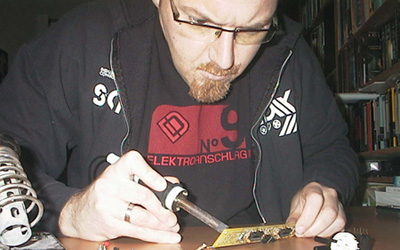In this third episode we have come to the point where I can be quite sure that you are willing ‘to give it a try’. Either that or you are more of an electronics freak then I am and you’re waiting for me to fall flat on my face so you can use the comments to set me straight and make fun of me in public. Feel free to do so, as I may be an old fart, I will also eagerly admit one is never too old to learn.
There are a few terms I’ll explain so we can talk more easily in the coming few paragraphs. Firstly there is the PCB or Printed Circuit Board. This is the little flat thingy that makes the actual electronic components work as they should.
Then there are the components, divided into the small ones that need soldering on the PCB, as well as the bit bigger stuff like switches, pot-meters (variable resistors) and plugs or connectors for cables.
Thirdly there is the casing, which can range from a 19″ rack with nicely designed faceplates to a solid oak cabinet holding a full 3-keyboard church organ. Or maybe a box which held the cigars from your grandfather, or a box used around the bottle of wine, or a cookie-tin, or…
There is a choice of four basic options for DIY stuff. These are:
a) The Do it ALL Yourself method;
b) Just the PCB;
c) The Bare Bones kit and
d) The full package.
The “Do it ALL yourself” category is something I will not advice beginners to start with. It’s something I don’t do myself because it takes lots of time, way more gear then described in episode 2 and a thorough knowledge of electronics. You will have either nothing to work from, or only the schematics or the design from a PCB. It includes making of the PCB yourself.

For the PCB category there are several people, companies and communities online where you can get anything from intriguing to ultimately complex designs. These are sold without components, hardware and casing.
The Bare Bones kit mostly has the PCB and the components, but always read what a kit holds exactly to prevent you ordering the remainder or visit Radio Shack three times a week.

The full package includes everything, even a casing. Which maybe limits you in having the fun of designing your own system or case, but it will leave you with more time to actually make music.
The best thing where you can start as a real beginner/’first-timer’ is either a ‘Bare Bones kit’ or a ‘full package’. It will give you some idea of what it is to make things without the nasty stuff like looking online for ‘that one sold-out chip’. Believe me, that is not a funny way too spend your evenings.

I’ll leave you with a few links to sites with products and the different kind of kits you could get as a first kit. This off course depends on what you want to spend on your first playable homemade synth.
www.synthrotek.com – No personal experience with these guys, but they do have a nice assortment of low-key and low-fi things. And the price is good …
www.musicfromouterspace.com – Great newcomer in the DIY scene. Good service and I got a free pen when I bought my WSG ;-)
store.curiousinventor.com – The combination of the three “Voice of Saturn” machines seems like a nice collection. No personal experience though.
www.buildyourownclone.com/fxkitindex.html – Loads of possible effects for guitar as well as synths. Also no personal experience.
www.paia.com – Home of the “Fatman” and many other DIY kits. They also have a theremin and they’ve been around for many years.
www.casperelectronics.com – Recently I bought the “DroneLab” and it worked at once. Full kit is maybe expensive, and it’s not for beginners (!). But if you already had some experience, this might be like the “Fatman”: a nice ‘somewhat bigger’ project.
www.makershed.com/ProductDetails.asp?ProductCode=MKJR2 – The “Atari Punk Console” is the mother of all DIY projects. This is one of the places where they sell a Bare Bones kit, but with a bit of googling you will definitely find more and others. For example the before mentioned SynthroTek site.
P.S.: Don’t forget there are also loads of people showing off their projects on Youtube. If you think you found something, look for more info before you tie the knot ;-)
P.P.S.: This is way more then 500 words, so don’t complain I write slow !!!

rotor
hey bauke, great shit! just ordered last week at makershed;-)
Bauke van der Wal
thnx roger :-)
what did you order?
keep us informed on service and delivery etc.
always interesting as additional info’s ;-)
benj
Hey, great idea for a series of articles, I only got into this kind of thing quite recently, and it’s quite daunting at first, with a lot of the information available assuming some sort of background knowledge (which I didn’t have).
I’d add http://www.narrat1ve.com to your list as well, the WTPA sampler was the first kit I built (after a bit of tinkering, might not be suitable form someone not at least a little handy with a soldering iron), which was great fun to build and to play with as well. Todd’s not got anything available at the moment, but the second generation is under way (updates seem to be few and far between at the moment, so not sure when to expect it).
I would also recommend anyone interested in getting into this type of DIY to spend a while browsing forums like the DIY section of electro-music and experimentalists anonymous. I found this really useful just to get an idea of what is possible and how things work at a broad stroke, and you also get pretty pictures and videos of nice things people have made to inspire you to work at it.